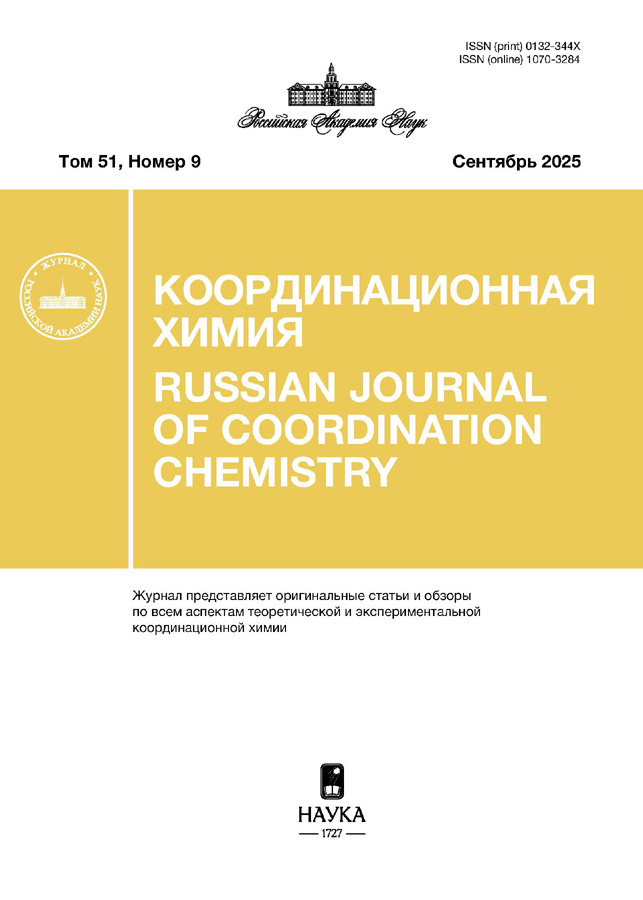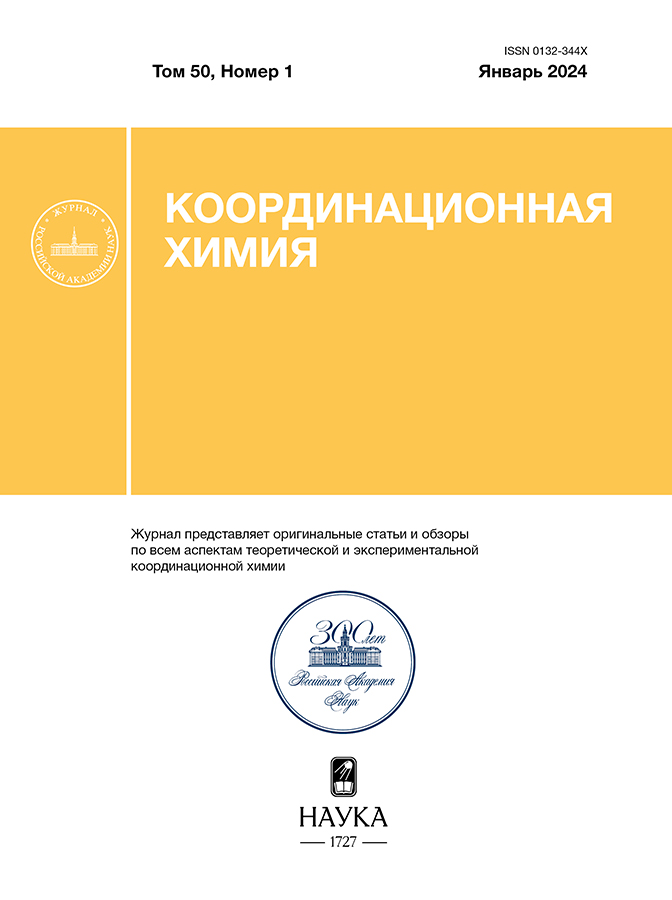Синтез, молекулярное и кристаллическое строение 3-(2-метилфенил)-2-селеноксо-2,3-дигидрохиназолин-4(1H)-она и его комплекса c Cd(II)
- Авторы: Аскеров Р.К.1, Чипинский Е.В.2, Перегудов А.С.3, Османов В.К.2, Мацулевич Ж.В.2, Борисова Г.Н.2, Хрусталев В.Н.4,5, Смирнова О.Н.6, Магеррамов А.М.1, Борисов А.В.2
-
Учреждения:
- Бакинский государственный университет
- Нижегородский государственный технический университет им. Р. Е. Алексеева
- Институт элементоорганической химии им. А. Н. Несмеянова РАН
- Российский университет дружбы народов
- Институт органической химии им. Н. Д. Зелинского РАН
- Национальный исследовательский Нижегородский государственный университет им. Н. И. Лобачевского
- Выпуск: Том 50, № 1 (2024)
- Страницы: 26-40
- Раздел: Статьи
- URL: https://kld-journal.fedlab.ru/0132-344X/article/view/667626
- DOI: https://doi.org/10.31857/S0132344X24010049
- EDN: https://elibrary.ru/OSNWSM
- ID: 667626
Цитировать
Полный текст
Аннотация
Реакцией метилантранилата с 2-метилфенил-изо-селеноцианатом в кипящем абсолютном этаноле синтезировано новое соединение 3-(2-метилфенил)-2-селеноксо-2,3-дигидрохиназолин-4(1Н)-он (HL). Свободный лиганд HL, являющийся селоном, предварительно был переведен в соответствующий селенолят натрия [C15H11N2OSeNa] (I), который затем без выделения использовался в реакции с хлоридом кадмия. Эта реакция привела к образованию комплекса [Cd2(μ-L)2(L)2(C2H5OH)2] (II). Строение соединений установлено методом РСА (CCDC № 2142342 (НL) и 2246014 (II)) и спектроскопией ЯМР (1Н,13С,15N и 77Se). В кристалле молекулы HL образуют одномерные цепочки за счет контактов H…O и H…Se и чередуются в синдиотактическом порядке. Соединение II представляет собой центрсимметричный биядерный комплекс состава [C64H56Cd2N8O6Se4]. Атомы кадмия в комплексе II гексакоординированы двумя хелатными анионными лигандами L–. Согласно результатам ЯМР-исследований, в растворе ДМСО-d6 свободный лиганд HL имеет селоновое строение, а в кадмиевом комплексе II он находится в селенолятной форме, что согласуется с данными о кристаллической структуре соединений, полученными методом РСА.
Полный текст
Об авторах
Р. К. Аскеров
Бакинский государственный университет
Автор, ответственный за переписку.
Email: rizvankam@bk.ru
Азербайджан, Баку
Е. В. Чипинский
Нижегородский государственный технический университет им. Р. Е. Алексеева
Email: rizvankam@bk.ru
Россия, Нижний Новгород
А. С. Перегудов
Институт элементоорганической химии им. А. Н. Несмеянова РАН
Email: rizvankam@bk.ru
Россия, Москва
В. К. Османов
Нижегородский государственный технический университет им. Р. Е. Алексеева
Email: rizvankam@bk.ru
Россия, Нижний Новгород
Ж. В. Мацулевич
Нижегородский государственный технический университет им. Р. Е. Алексеева
Email: rizvankam@bk.ru
Россия, Нижний Новгород
Г. Н. Борисова
Нижегородский государственный технический университет им. Р. Е. Алексеева
Email: rizvankam@bk.ru
Россия, Нижний Новгород
В. Н. Хрусталев
Российский университет дружбы народов; Институт органической химии им. Н. Д. Зелинского РАН
Email: rizvankam@bk.ru
Россия, Москва; Москва
О. Н. Смирнова
Национальный исследовательский Нижегородский государственный университет им. Н. И. Лобачевского
Email: rizvankam@bk.ru
Россия, Нижний Новгород
А. М. Магеррамов
Бакинский государственный университет
Email: rizvankam@bk.ru
Азербайджан, Баку
А. В. Борисов
Нижегородский государственный технический университет им. Р. Е. Алексеева
Email: rizvankam@bk.ru
Россия, Нижний Новгород
Список литературы
- Shtefan E.D., Vvedenskii V. Y. // Russ. Chem. Rev. 1996. V. 65. P. 307. https://doi.org/10.1070/RC1996v065n04ABEH000212
- Akkurt M., Ozturk S., Servi S. et al. // Acta Crystallogr. E. 2004. V. 60. P. 1507. https://doi.org/10.1107/S1600536804019099
- Buzykin B.I., Mironova E. V., Gubaidullin A. T. et al. // Russ. J. Gen. Chem. 2008. V. 78. № 4. P. 634. https://doi.org/10.1134/S107036320804021X
- Аскеров Р.К., Магерамов А. М., Османов В. К. и др. // Журн. структур. химии. 2018. Т. 59. № 7. С. 1717. https://doi.org/10.26902/JSC20180719.
- Askerov R.K., Magerramov A. M., Osmanov V. K. et al. // Russ. J. Coord. Chem. 2019. V. 45. № 2. P. 112. https://doi.org/10.1134/S1070328419020039
- Askerov R.K., Magerramov A. M., Osmanov V. K. et al. // Russ. J. Coord. Chem. 2019. V. 45. № 8. P. 668. https://doi.org/10.1134/S1070328419070017
- Rizvan K.A., Maharramov A. M., Khalilov A. N. et al. // Acta Crystallogr. E. 2020. P. 1007. https://doi.org/10.1107/S2056989020007033
- Osmanov V.K., Chipinski E. V., Askerov R. K. et al. // Russ. J. Coord. Chem. 2021. V. 47. № 1. P. 32. https://doi.org/10.1134/S1070328421010048
- Askerov R.K., Osmanov V. K., Kovaleva O. N. // Russ. J. Coord. Chem. 2021. V. 47. № 11. P. 741. https://doi.org/10.1134/S1070328421110014
- Osmanov V.K., Chipinsky E. V., Khrustalev V. N. // Molecules. 2022. V. 27. P. 5799. https://doi.org/10.3390/molecules27185799
- Song J.-F., Wang J., Li Si-Z. et. al. // J. Mol. Struct. 2017. V. 1129. P. 1.
- Hernandez-Arganis M., Moya-Cabrera M., Jancik V. et al. // Inorg. Chim. Acta. 2018. V. 475. P. 83. https://doi.org/10.1016/j.ica.2017.07.062
- Hernandez-Arganis M., Toscano R. A., Moya-Cabrera M. et al. // Z. Anorg. Allg. Chem. 2004. V. 630. P. 1627. https://doi.org/10.1002/zaac.200400183
- Muhammad I., Andreas M., Neumann B. et al. // Dalton Trans. 2014. V. 43. № 39. P. 14737. https://doi.org/10.1039/C4DT01931H
- Li Y., Wang C. Q., Bian H. D. // J. Coord. Chem. 2012. V. 65. № 20. P. 3665.
- Ilie A., Rat C. I., Scheutzow S. et al. // Inorg. Chem. 2011. V. 50. P. 2675. https://doi.org/10.1021/ic102595d
- Sanina N.A., Kozub G. I., Kondrat’eva T.A. et al. // J. Mol. Struct. 2013. V. 1041. P. 183. https://doi.org/10.1016/j.molstruc.2013.03.021
- Bharty M.K., Dani R. K., Kushawaha S. K. et al. // Polyhedron. 2015. V. 88. P. 208. https://doi.org/10.1016/j.poly.2015.05.045
- Taheriha M., Ghadermazi M., Amani V. // J. Mol. Struct. 2016. V. 1107. P. 57. https://doi.org/10.1016/j.molstruc.2015.11.012
- Askerov R.K., Youness El Bakri, Osmanov V. K. // J. Inorg. Biochem. 2022. V. 231. P. 111791. https://doi.org/10.1016/j.jinorgbio.2022.111791
- Askerov R.K., Ashfaq M., Chipinsky E. V. et al. // Results Chem. 2022. V. 4. 100600. https://doi.org/10.1016/j.rechem.2022.100600
- Yadav S., Deka R., Singh H. B. // Chem. Lett. 2019. V. 48. P. 65. https://doi.org/10.1246/cl.180748
- Yadav S., Singh H. B., Butcher R. J. // Eur. J. Inorg. Chem. 2017. V. 23. P. 2968. https://doi.org/10.1002/ejic.201700218
- Karri R., Chalana A., Kumar B. et al. // Chem. Eur. J. 2019. V. 25. № 55. P. 12810. https://doi.org/10.1002/chem.201902578
- Isab A.A., Wazeer M. I.M., Fettouhi M. et al. // Poly-hedron. 2006. V. 25. P. 2629. https://doi.org/10.1016/j.poly.2006.03.022
- Henderson R., Rothgery E. F., Schroeder H. A. Patent U. S. № 4496559. 1985.
- Patent CN. 104447532A. 2015.
- Askerov R.K., Magerramov A. M., Matsulevich Z. V. et al. // Russ. J. Coord. Chem. 2019. V. 45. P. 320. https://doi.org/10.1134/S1070328419030011
- Ninomiya M., Garud D. R., Koketsu M. // Coord. Chem. Rev. 2011. V. 255. P. 296. https://doi.org/10.1016/j.ccr.2011.07.009
- Garud D.R., Koketsu M., Ishihara H. et al. // Molecules. 2007. V. 2. P. 504. https://doi.org/10.3390/12030504
- Heimgartner H., Zhou Y., Plamen K. et. al. // Phosphorus, Sulfur, and Silicon and the Relat. Elem. 2008. V. 183. P. 840. https://doi.org/10.1080/10426500801898135
- Zakrzewski J., Huras B., Kiełczewska A. // Syn thesis. 2016. V. 48. P. 85. https://doi.org/10.1055/s-0035–1560481
- CrysAlisPro. Version 1.171.41.106a. Rigaku Oxford Diffraction, 2021.
- Sheldrick G. M. Acta Crystallogr. C. 2015. V. 71. P. 3. https://doi.org/10.1107/S2053229614024218
- Бацанов С.С. // Журн. неорган. химии. 1991. Т. 36. Вып. 12. С. 3015.
- Christoph J. // Dalton Trans. 2000. P. 3885. https://doi.org/10.1039/B003010O.
Дополнительные файлы


























